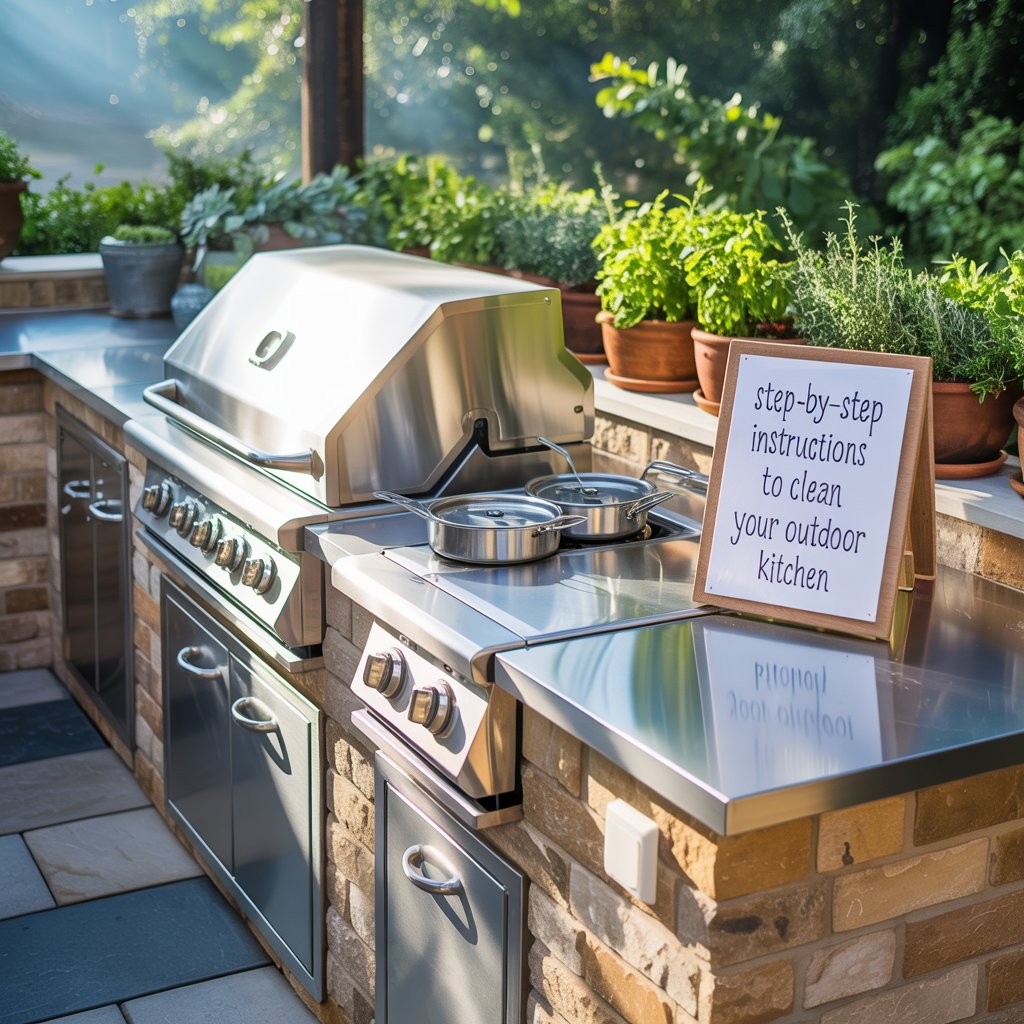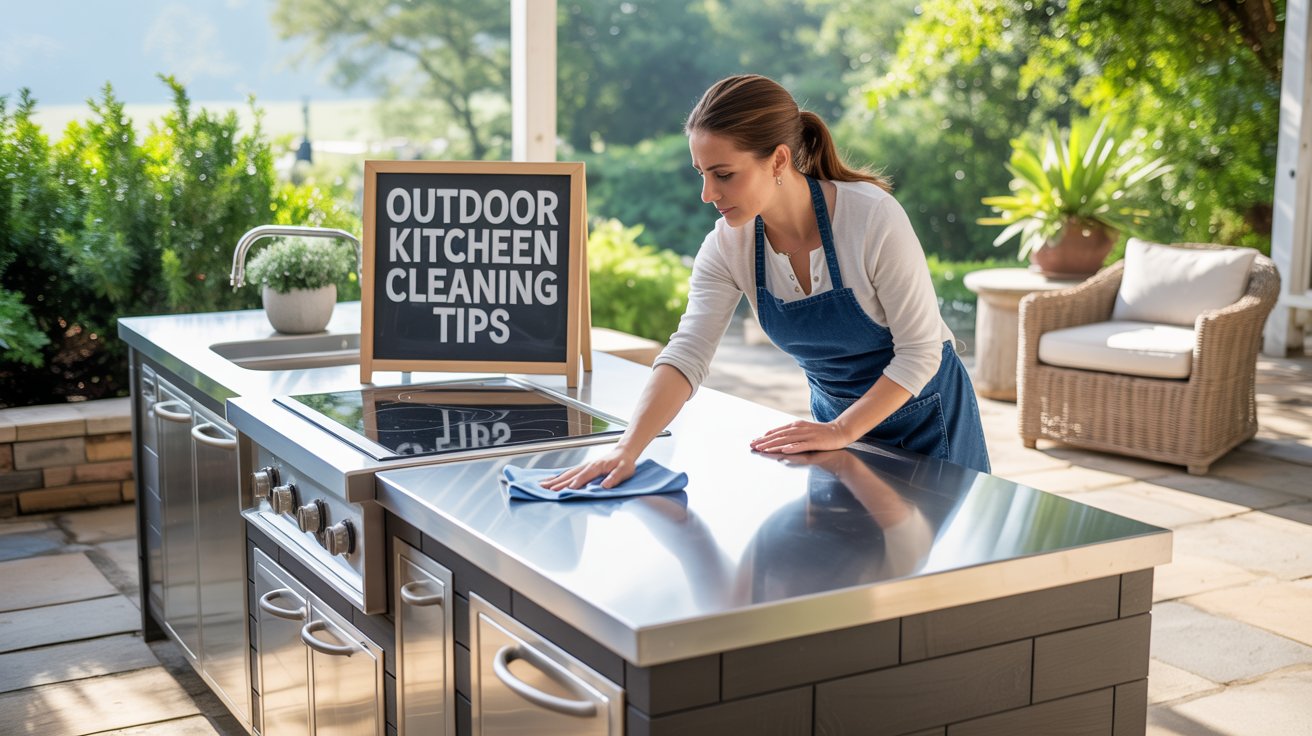An outdoor kitchen isn’t just a backyard upgrade it’s a lifestyle enhancer, blending culinary freedom with open-air ambiance. But to keep it welcoming and efficient, consistent upkeep is essential. Neglect invites grime, rust, and wear.
From grease-slicked grills to weather-worn countertops and water-stained sinks, each element demands attention. Scrub, polish, rinse repeat. Regular maintenance not only preserves function but elevates the entire experience. Here’s your no-nonsense guide to cleaning every surface, appliance, and nook, step-by-step. Let’s make outdoor cooking effortless.
What You Will Need for Outdoor Kitchen Cleaning
| Item | Purpose |
|---|---|
| Gloves | Protect your hands during cleaning |
| Soft cloths or sponges | Wiping surfaces without scratching |
| Brushes (wire and soft) | Scrubbing grills and hard-to-reach areas |
| Mild dish soap | General cleaning of surfaces |
| Degreaser | Breaking down tough grease |
| Baking soda | Natural abrasive for grills and sinks |
| White vinegar | Disinfecting and removing mineral stains |
| Hose with spray nozzle | Rinsing and washing down dirt |
| Grill scraper/wire brush | Cleaning grill grates and burners |
| Stainless steel cleaner | Polishing metal surfaces |
Step-by-Step Instructions to Clean Your Outdoor Kitchen

1. Clear the Area and Remove Debris
Clear every countertop and shelf by removing all utensils, cookware, and decorative pieces nothing should remain. Next, tackle the mess beneath your feet and around your space: sweep thoroughly or grab a leaf blower to banish dust, scattered leaves, and lingering food bits from the floor and other surfaces.
This crucial first step sets the stage for deep cleaning. By stripping the area bare and removing debris, you create a clean slate, ensuring every nook and surface is ready for a proper scrub.
2. Clean the Grill Thoroughly
Remove grill grates and burners. Use a wire brush or grill scraper to brush off leftover residue and charred bits. For stubborn grime, apply a paste of baking soda and water, let it sit for a few minutes, then scrub. Wash grates in warm soapy water or soak them if baked-on foods persist. Wipe the grill’s exterior with mild soapy water and rinse.
3. Degrease Countertops and Cabinets
Begin by generously spraying a suitable degreaser or warm soapy solution across your countertops and cabinets. Let it sit briefly to break down stubborn grease. Using a soft-bristled brush or non-abrasive sponge, scrub gently but thoroughly, paying extra attention to corners and edges where grime tends to linger.
Once the surface looks clean, rinse everything down with clean water to eliminate any leftover residue—leaving behind a fresh, grease-free finish that’s ready to shine. Don’t skip the rinse—it’s key.
4. Clean the Sink and Faucets
To tackle stubborn sink and faucet grime, blend baking soda with vinegar or opt for a gentle soap—both cut through mineral buildup and stains effectively. For those tight, tricky spots, an old toothbrush works wonders. Scrub with care, reaching into crevices where dirt hides.
Once clean, rinse thoroughly with warm water to wash away residue. If your fixtures are stainless steel, finish with a specialized polish to restore their gleam and shine. It’s a simple yet transformative cleaning ritual.
5. Wipe Down Outdoor Furniture
To refresh outdoor furniture, begin by gently wiping down tables, chairs, and cushions with a damp cloth dipped in mild soapy water just be sure the fabric or material can handle it.
For plastic or metal pieces, consider a more invigorating approach: mix equal parts vinegar and water to create a natural disinfectant that also banishes lingering odors. This method not only cleans effectively but leaves your furniture smelling crisp and renewed, ready for those laid-back afternoons outdoors.
6. Sweep and Rinse Floors
Start by sweeping away loose dirt, leaves, and debris to clear the surface. Once the area is free of clutter, use a garden hose to rinse it thoroughly. If you encounter stubborn stains or patches of grime, grab a stiff-bristle brush and gently scrub using a solution of warm water and mild detergent.
Be cautious avoid using a power washer on delicate materials, as the intense pressure can cause cracks, chips, or even strip away protective coatings over time.
7. Clean Kitchen Appliances
Give refrigerator exteriors and storage units a thorough wipe-down using a soft cloth, warm water, and a gentle soap solution. Periodically check for frost buildup defrost as needed, scrubbing shelves clean and tossing anything past its prime.
Don’t overlook hidden messes. When it comes to ventilation hoods, inspect the filters regularly grime builds up fast. Clean or swap them out based on what the manufacturer recommends to keep airflow smooth and kitchen odors under control.
8. Organize and Protect
Once every surface is thoroughly dried, take a moment to thoughtfully return your utensils and cookware to their proper places. Rather than tossing everything back in haphazardly, consider investing in weather-resistant cabinets or durable storage bins.
These not only shield your essentials from harsh outdoor conditions but also help maintain a clean, organized cooking space. A well-kept outdoor kitchen doesn’t just look better—it functions more efficiently, too. Small details like this make a big difference in long-term maintenance and usability.
Understand Outdoor Kitchen Cleaning Better

- Seasonal Maintenance: Before colder months or after heavy use, deep clean and check plumbing to prevent freezing or damage.
- Countertop Care: Different materials like stone, concrete, or stainless steel require specific cleaning agents and sealing to preserve their finish.
- Grill Maintenance: Regular cleaning prevents rust and ensures better cooking performance; replacing parts like burner protectors as needed enhances longevity.
- Pest Prevention: Keeping the area clean reduces attraction for insects or rodents that can damage your outdoor kitchen.
Conclusion
Regular cleaning and maintenance of your outdoor kitchen not only keep it looking appealing but also extend its lifespan and improve your cooking experience. By following these detailed steps and using proper materials, you protect your investment and enjoy your outdoor culinary space for years to come.
Frequently Asked Questions
Q: How often should I clean my outdoor kitchen?
A: Light cleaning (wiping surfaces, clearing debris) should be done after each use, with a deeper clean—especially the grill and appliances—conducted monthly or seasonally.
Q: Can I use household cleaners on outdoor kitchen surfaces?
A: Mild dish soap and water are generally safe. Avoid harsh chemicals on stone, concrete, or specialty finishes and use cleaners recommended by the manufacturer for stainless steel.
Q: How do I protect my outdoor kitchen in winter?
A: Drain water lines to prevent freezing, clear food debris, cover appliances and grills, and perform a thorough cleaning before the cold sets in.
Q: What is the best way to clean a grill grate?
A: Scrape off residue with a wire brush, soak in warm soapy water or vinegar water solution if needed, then scrub and rinse well.
